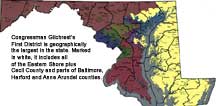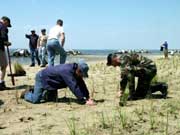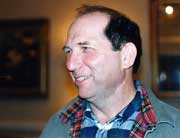 |
||||||
|
Volume 13, Issue 10 ~ March 10 - 16, 2005
|
||||||
|
|
 ~ Bay Weekly Interview ~ with Sandra Olivetti Martin ~ Bay Weekly Interview ~ with Sandra Olivetti MartinU.S. Congressman Wayne Gilchrest Chesapeake Bay’s Man with a PlanIn the short term, revamping the Chesapeake Bay Program. In the long term, creating wildlife corridors across the nation. In the middle, not so soon on Asian oysters. About wayward Chesapeake Bay, Congressman Wayne Gilchrest is a man with a plan. At 21 years old, the Chesapeake Bay Agreement — whose job it is to put the Bay back on track — is too much like a kid old enough to amount to something but going nowhere fast. Gilchrest, a former high school teacher whose three children are now older than the Bay Agreement, knows a thing or two about moving past adolescent inertia. Now, Gilchrist, an unconventional Republican, is trying to push Chesapeake Bay restoration out of idle. The U.S House Resources subcommittee Gilchrest chairs considers the future of oceans, bays and their fisheries. So Gilchrest might well have the power to shift our Bay’s massive, $800-million yearly effort into gear. In a year when war and tax cuts mean lean times for needs at home, there’ll be no additional money to do the job. So Gilchrest is going for a bigger bang from existing bucks. We caught up with the Republican congressman at the noon hour, after he’d spent some time with state legislators from both Anne Arundel County and the Eastern Shore. Both regions are part of his Bay-crossing congressional district. Geographically the largest district in the state, the First includes all of the Eastern Shore plus Cecil County and parts of Baltimore, Harford and Anne Arundel counties. We squeezed into opposite sides of a booth at Chick and Ruth’s Delly in downtown Annapolis. The wall behind the landmark’s lunch counter boasts specials named for the political elite of Annapolis and the state. As it appears on the wall of fame, Gilchrest’s special is hot pastrami, hot corned beef and Swiss cheese on rye. That, however, is not a special on Gilchrest’s menu. “I don’t even know what pastrami is,” said the 58-year-old congressman, who grew up in Rahway, New Jersey. “They didn’t want to put up what I really eat: peanut butter, mayonnaise and Swiss cheese,” said Gilchrest, who claims to have acquired the taste in his youth. “It’s best on a kaiser roll.” That’s not the only way the real Wayne Gilchrest defies stereotypes. Every primary season, the seven-term congressman has to fend off contending right-wing Republicans spending big bucks to try to send him home from Congress, where he was landed by a broken jaw. This noon, his tastes ran to scrambled eggs, home fries and rye toast, with a single cup of coffee. Bay Weekly What are we going to do about Chesapeake Bay? You held hearings in Annapolis in December, asking people what they thought. Now, do you have a plan? Wayne Gilchrest We know what causes the Chesapeake’s problems and how to stop those degrading factors. What’s left is to organize ourselves to do it. That’s what we’re doing now. We know its pollution, we know how to stop. Now we need money targeted to restoration.
Wayne Gilchrest What’s holding us up used to be money. We cannot make a difference without money. But we can do better with the money that we’ve got now. The Chesapeake Bay Program is funded at only about $20 million, and everybody seems to be focused on raising that. But the organizational chart of Chesapeake Bay restoration is more complicated than the theory of relativity. When you count the Bay budgets of the Department of Agriculture, the Army Corps of Engineers, EPA, the Department of the Interior through the Fish and Wildlife Service — plus the money for the Bay from states and then counties and then the private sector — that $20 million is in fact about $800 million. But it is so disbursed in little pockets, so fragmented, that it’s like pouring money into a strainer. Bay Weekly What’s the solution? Wayne Gilchrest We want to make the Chesapeake Bay Program the conduit for all the money spent on the Bay so that restoration can be more direct. That means restructuring the Bay Program, which has been basically a research arm of EPA, to evaluate the Bay. What we want to do is leave that role while making it a conduit money can flow through and an aggressive advocate for the Bay. Bay Weekly So the plan is to redesign the Chesapeake Bay Program? Wayne Gilchrest I don’t have all the answers now. We’re working out the answers through the House Chesapeake Bay Task Force. I’m the chair along with Congressman Bobby Scott of Virginia. We meet face to face once a week with people interested in reforming the restoration effort. Last week we met with Virginia Gov. Mark Warner and Maryland Gov. Robert Ehrlich. The week before that it was the Chesapeake Bay Commission. Next week, it’s the Army Corps of Engineers. We’re piecing it all together; then we will develop legislation to calibrate the Bay Program to capture all the money. Bay Weekly It has been hard for people to keep the faith when they don’t know where their money and effort are going and how it’s making a difference. Wayne Gilchrest This plan means people in Pennsylvania and West Virginia or Virginia or Delaware, as well as here in Maryland or wherever, who are contributing money through taxes or surcharges or voluntarily, are going to know what everyone else is doing. So we get better bang for our buck. It would make a huge difference. I also think that on an annual basis all across the Bay, the Bay Program and its partners should give public presentations on progress, whether in 10 different town meetings or on Maryland Public Television. Bay Weekly What’s the time frame? Wayne Gilchrest We’re several months away from understanding how the financing can be effected. I expect we’ll have the legislation developed sometime in October or November, though we may not vote until after the new year in early ’06. Bay Weekly Who are your allies? Wayne Gilchrest Most of the members of the Bay Task Force are strongly in favor of our effort, including a number of members on the Appropriations committee, who make funding decisions. James Walsh of New York, Frank Wolf from Virginia, of course Steny Hoyer and the Maryland delegation plus senators Paul Sarbanes and Barbara Mikulski. Also the Chesapeake Bay Program, which we’re talking about, and the Chesapeake Bay Foundation. Bay Weekly Will your plan balance the losses of millions of dollars to Bay restoration in President George W. Bush’s upcoming federal budget? Wayne Gilchrest We can make more progress with $800 million, but the $15 billion [estimated to restore Chesapeake Bay] laid out in a financing framework by the special blue ribbon panel is an accurate figure for the watershed. Bay Weekly Any ideas on new sources of Bay revenue? Wayne Gilchrest I think Maryland did a good thing with last year’s flush tax. Bay Weekly I see you call it a tax despite your Republican party’s aversion to new taxes? Wayne Gilchrest Fee or tax, I don’t care — though I tried to call it a fee when I was advocating it to Eastern Shore county commissioners. Bay Weekly Have you been talking up this plan in your meetings with state legislators? Wayne Gilchrest Also Project Open Space. I recommended they vote for a piece of state legislation that would require the state to use Project Open Space money — raised by transfer taxes on real estate — the way it was intended. That’s to purchase easements or buy land; it’s not to go into the general fund. If you target land in critical watersheds for Open Space purchase, nature will continue to buffer the Bay. Bay Weekly The state has been borrowing that money? Wayne Gilchrest The state has robbed it. It’s theft. That money was put into place by Marylanders who gladly pay so land can be protected. That’s the intention, not so you can pull it out at will. Bay Weekly What did the state lawmakers say? Wayne Gilchrest They nodded. Bay Weekly Like the flush tax, Project Open Space is a state initiative using money directly and specifically out of citizens’ pockets. But you’re a federal lawmaker. Do you stand on the authority of your position to talk about such issues? Wayne Gilchrest The most power anybody has is just your ability to influence. You can’t put somebody in jail for holding different opinions, so you use your powers of persuasion. I’ve known most of them 10 or 15 years, so I try to talk to them one person to another. That’s a fundamental reality of the democratic process. President Bush can’t tell me how to vote but only use his skill in persuading. The same thing with Governor Ehrlich and the General Assembly. The worst kind of politics is one that threatens another elected official. That borders on evil. Bay Weekly For a politician, you seem remarkably unimpressed with your position. Wayne Gilchrest I talk citizen to citizen. I don’t know how to do it any other way. I don’t feel any different right know than I did in the fall of 1986 halfway up a mountain sheltering under a pine tree with my two boys in the middle of rain and snow. I had no job, my wife had gone back to Maryland and we were following the tracks of a mountain goat. The strangest thing about being there — so here — was that it didn’t feel strange to me. Bay Weekly You followed that mountain goat, but you don’t always fall in step with your own party, and you don’t always agree with Governor Ehrlich. Wayne Gilchrest Yeah … [The rest of the answer is spoken in body language, with a wry smile and a perhaps mischievous glint of eye.] Bay Weekly One of your disagreements with the governor is how quickly the Asian oyster Ariakensis might be adopted in our Bay. Wayne Gilchrest That’s right. We shouldn’t hurry. If you look at any scientific research protocol, a method has been developed for evaluating things. In evaluating the Asian oyster, that method means a number of life cycles to see how it reacts to certain conditions. Not one life cycle. It’s a living, breathing entity bringing virtually an infinite number of variables. Five years is barely enough, but five could do. So I am encouraging the state to follow the National Academy of Science recommendations for testing over five years. Bay Weekly What are people who live off the water telling you? Wayne Gilchrest When I run into watermen while I’m canoeing, they ask me that question. They’re tentative, they’re not getting all the information because they’re hearing different stories. The Corps of Engineers, the researchers at [University of Maryland’s Center for Environmental Studies at] Horn Point say we can develop disease-resistant Virginica, the native strain. Some in Maryland Department of Natural Resources are saying they’re dead, but watermen have a feeling we can save native oysters. But people in the restaurant business want a quick fix. The best thing we can do as policy makers is to clear the way to the best science.
Wayne Gilchrest I haven’t seen anything yet from the administration specifically but we’re vigilant about anything we see, certainly from House or Senate side under the guise of reforming the Endangered Species Act. Bay Weekly Beyond vigilance in protection of the Endangered Species Act, what are you doing to protect species? Wayne Gilchrest We’re trying to do two things that will solve the problem. One is habitat, making sure there is enough. You don’t worry about species becoming endangered if you set aside habitat. We did away with pesticides, so now many endangered species like eagles are coming back. The next big danger is loss of habitat, and the cure for that is setting aside enough land, which we can do. In 1950, the federal government embarked on a 50-year endeavor to create a highway system of corridors for human beings to move back and forth. Today we need an interstate corridor for wildlife that works much the same way. Bay Weekly Is such a program on the horizon? Wayne Gilchrest We’re nowhere near a specific program. I talk about it a lot, but it takes a while to get into the brains of other members. So we have ongoing legislative policy discussions on the concept of corridors. And we have a pilot program called the Delmarva Peninsula Conservation Corridor, where we’re trying to create an agricultural corridor from Virginia to Pennsylvania with wildlife in the same area. To keep Delmarva rural and preserve habitat for wildlife, you have to make agriculture economically viable, so you don’t become a bedroom community for the metropolis. Bay Weekly And the second part of your plan for preserving wildlife … Wayne Gilchrest The second thing we need to do for species is improving the quality of both water and life. Our infrastructure — buildings, highways, sewer plants — should be engineered so they’re compatible with nature’s system and not at odds. Nature cleans its own air with oceans, trees, grasslands and wetlands. Nature cleans its own system, even animal and human wastes. We’ve made prostheses; sewer plants and emission scrubbers are artificial limbs that never work as well as the real one does. Now we need to get back to engineering and designing our infrastructure the way nature does. It’s hard to do but not impossible.
|
|||||
|
© COPYRIGHT 2004 by New Bay Enterprises, Inc. All rights reserved. |



 Snapshots from an Unconventional Biography
Snapshots from an Unconventional Biography